
In South Africa approximately 35% of all road fatalities are pedestrian fatalities. We have shared information on the Arrive Alive road safety website with our pedestrians on how to avoid becoming road crash fatalities. These include the need for increased visibility around traffic, the need for alertness etc.
We have also shared safety suggestions with drivers when driving in the vicinity of pedestrians. When these drivers however do not reduce their speeds as advised it is often up to the road engineers to reduce the risks of speeding vehicles through road design and traffic calming.
In this section we would like to pay closer attention to traffic calming - sometimes referred to as speed calming, and discuss how these measures can help to avoid road fatalities and injuries. We will also refer to other sections of content on the Arrive Alive website and share practical examples on how these measures have been implemented.
What causes pedestrians to be unsafe?
-
Vehicle / Pedestrian Conflict
-
Pedestrians sharing roadway with vehicles
-
At grade facilities (grade separated ideal)
-
At grade : angle at which pedestrians use road (Parallel, cross skew, at right angles)
-
Pedestrian behaviour is often unpredictable
Who are the defined Pedestrian Groups?
-
Children
-
Adults
-
Disabled
-
Aged
Important Concepts in Pedestrian Safety
We would like to take a closer look at some concepts in pedestrian safety to analyse how traffic calming can impact on the behaviour of both pedestrians and motorists to ultimately enhance safety and reduce road deaths.
|
Concept |
Responsible entity |
|
Engineering |
Roads authority |
|
Education |
Teachers and parents |
|
Enforcement |
Metropolitan Police |
Engineering Concepts
Separation
Space (separate walkways and roads for vehicular traffic, grade separation) (pedestrian bridge or underpass)
Time (allow pedestrians to take gaps, traffic signals)
Warning
Signs and marks
Mitigation
Reducing speeds (vast majority of cases)
Reducing volumes
Engineering Applications
It is the road engineers who have the technical knowledge and skills required for the implementation and construction of traffic calming measured. Their applications can be used at:
-
Junctions (Intersections)
-
Midblock
-
Public Transport Facilities
-
Schools / Other high pedestrian volume areas
Education Applications
Even though we might design and implement the best possible measures for traffic calming, this should not be seen in isolation of the important educational component of a traffic calming strategy.
Education:
-
Essential with any engineering intervention
-
Focus on different age groups
-
Children 6 – 12 years
-
Children over 12 years
-
Adults
-
Use text road signs to educate
-
“Responsible Pedestrian” licence?
Enforcement Applications
Once we have designed, constructed and implemented measures for traffic calming - and educated road users on how to interact with other road users at these road designs, we still need to enforce the Rules of the Road. Traffic Enforcement still remains one of the best measures to ensure obedience and increased safety!
Enforcement:
-
Sometimes only solution
-
Not aggressively enough at present
-
Pilot projects where pedestrians cross highways
-
Training of community traffic wardens
Engineering Toolbox
What are the tools available to the road engineer to create safety through traffic calming?
Some of the following may be used:
-
Painted or raised and painted edestrian crossings
-
Speed humps
-
Mini-circles
-
Sidewalks
-
Road signs
-
Taxi lay-byes
-
Median islands
-
Road marks
-
Illumination
-
Barriers and kerbs
-
Loading facilities at schools
-
Traffic signals
-
Scholar patrols
-
COSBI Strips
-
Rumble strips (mainly in rural areas)
Before implementing Traffic calming
What is required before implementing any measured for traffic calming?
-
Have a traffic calming policy in place (ratified by Council)
-
Have a Traffic calming Master Plan for whole or part of the town or city
-
Have an approved evaluation process (should be part of policy)
-
Have a public awareness / education process in place
-
There should be an awareness amongst officials that a policy and technical criteria exist
-
Have a recording and feedback system in place
Traffic Calming Master Plan
The Basics of Developing a Traffic Calming Master Plan for part or all of the area for which the roads authority is responsible:
-
Identify road safety problems before they occur
-
Study the area in terms of:
-
Road hierarchy
-
Traffic Volumes (vehicles and pedestrians)
-
Determine number of residential units
-
Land use (Schools, commercial developments, old age home etc)
-
Road geometry (vertical and horizontal alignments, cross sections etc)
Future planning
Evaluation Process
National Guidelines developed by CSIR are most commonly used
There are variations to this (CTMM uses an adapted variation of CSIR process
Centurion also developed its own method
Other authorities also developed their own processes
Traffic Calming Techniques
There is a wide range of traffic calming techniques. We would like to consider some of these and share examples of how they are implemented on our roads.
-
There are basically six different methods used to calm traffic (both volumes and speeds)
-
Vertical displacement (speed humps)
-
Horizontal displacement (mini-circles)
-
Lane width reduction (eg choker)
-
Auditory methods (rumble strips)
-
Visual methods (Cosbi strips)
-
Road closure
Examples of Traffic Calming
How do these traffic calming measures look like in the design phase? We would like to share a few examples of layouts of traffic calming measures:
Van Riebeeck, Molteno - Lyttelton�RPC and mini-circle
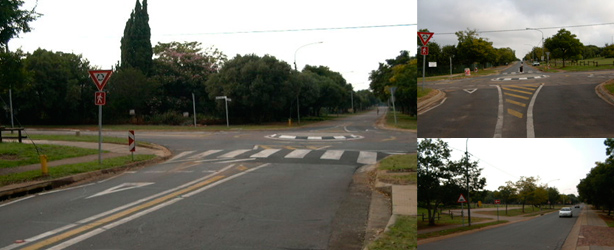
Van Riebeeck, Molteno - Lyttelton Placement of circle, signage
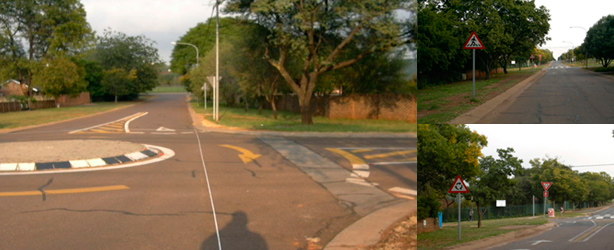
Kruger Ave, Lyttelton Choker, stormwater channel
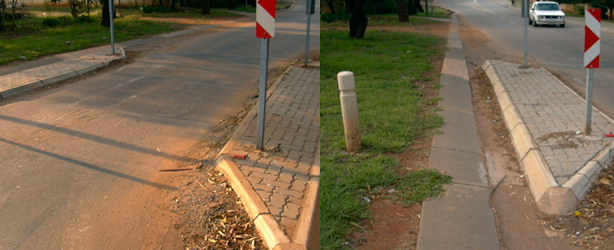
Chokers - Lyttelton
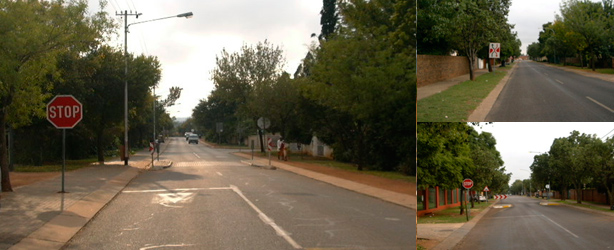
River Road and Service road - Lyttelton
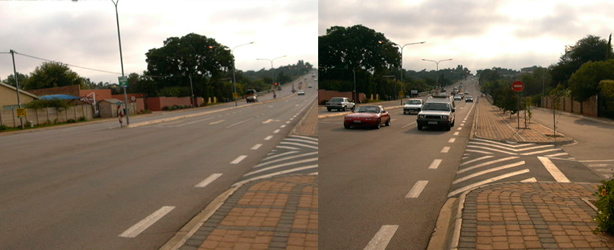
Irene Traffic calm due to reduced lane widths
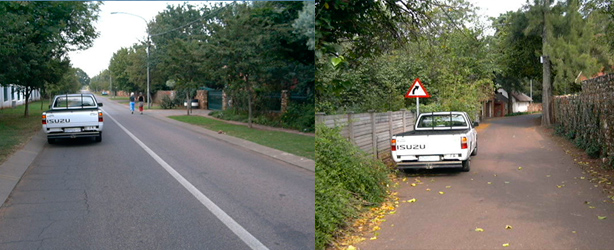
Intelligent use of Traffic Calming - Lyttelton Manor High School
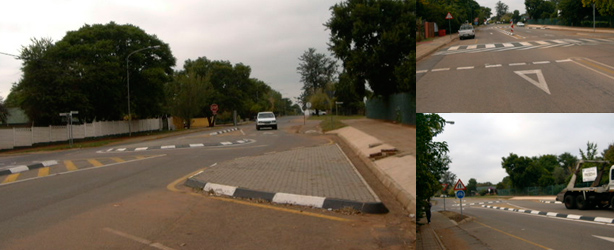
Lighting and painting of Traffic Calming Features
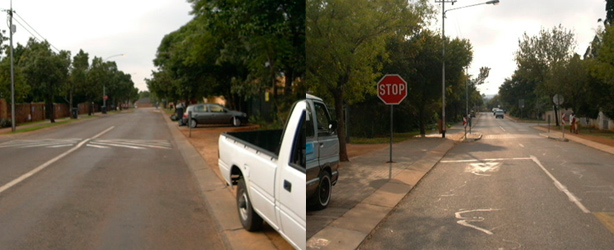
Lois Avenue 10,5m Roadway�Newlands�(Excessively wide lanes – has to be� rectified with Traffic Calming)

Lois Avenue Traffic Calming Newlands
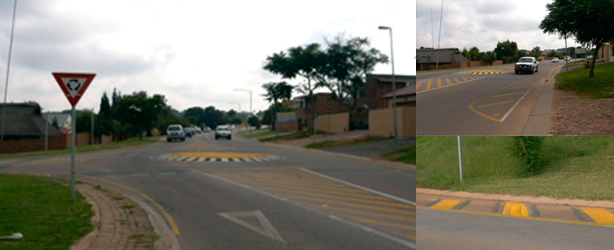
Typical Road Classes
Road Classes U1 and U2

Road Classes U3 and U4

Road Class U5
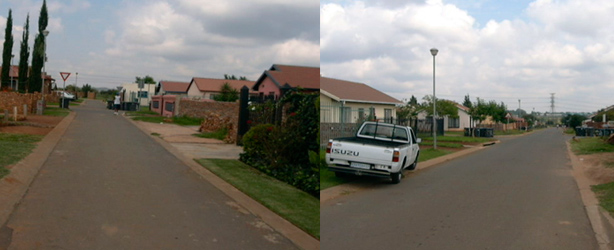
Road Class U6
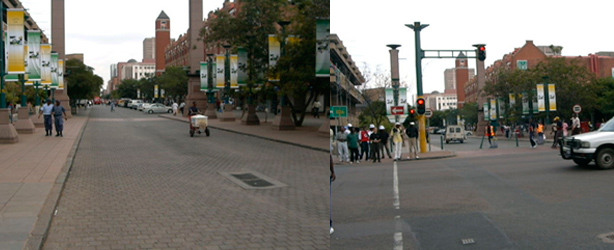
Road Class U6 - Woonerf
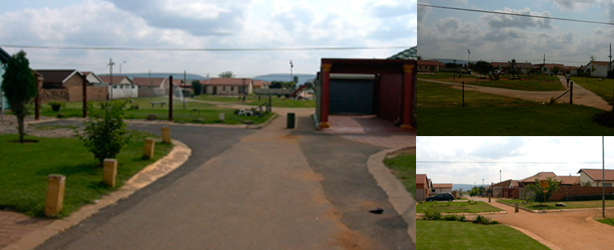
Zambesi Drive - class U2, U3, U4 and U5
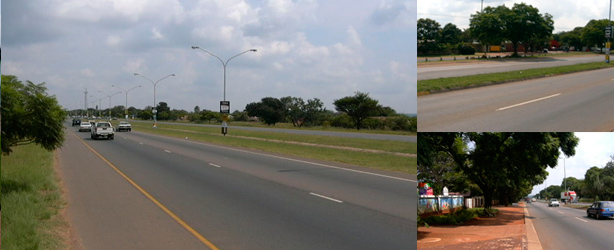
Also View: